Research on the Coordination of Transportation Network and Ecological Corridors Based on Maxent Model and Circuit Theory in the Giant Panda National Park, China
Abstract
1. Introduction
2. Materials and Methods
2.1. Study Area
2.2. Data Source and Pre-Processing
2.2.1. Distribution Data
2.2.2. Road Data
2.2.3. Environmental Data
2.2.4. Data Processing
2.3. Methods
2.3.1. Maxent Modeling and Circuit Theory
2.3.2. Two-Step Screening Method
2.4. Study Framework
3. Results
3.1. Habitat Suitability Assessment Based on the Maxent Model
3.1.1. Habitat Suitability Distribution
3.1.2. Ecological Source Distribution of Species
3.2. Construction of Wildlife Ecological Corridors Based on Circuit Theory
3.2.1. Integrated Species Resistance Surface Construction
3.2.2. Construction of Species Ecological Corridors and Identification of Ecological Conflict Points
3.3. Site Selection for Multifunctional Wildlife Crossings
3.4. Design of Multifunctional Wildlife Crossings
4. Discussion
4.1. Comparative Analysis of Existing Studies
4.2. Policy Recommendations
5. Conclusions
Author Contributions
Funding
Data Availability Statement
Acknowledgments
Conflicts of Interest
References
- Watson, J.E.; Dudley, N.; Segan, D.B.; Hockings, M. The performance and potential of protected areas. Nature 2014, 515, 67–73. [Google Scholar] [CrossRef]
- Tucker, M.A.; Böhning-Gaese, K.; Fagan, W.F.; Fryxell, J.M.; Van Moorter, B.; Alberts, S.C.; Ali, A.H.; Allen, A.M.; Attias, N.; Avgar, T.; et al. Moving in the Anthropocene: Global reductions in terrestrial mammalian movements. Science 2018, 359, 466–469. [Google Scholar] [CrossRef] [PubMed]
- Haddad, N.M.; Brudvig, L.A.; Clobert, J.; Davies, K.F.; Gonzalez, A.; Holt, R.D.; Lovejoy, T.E.; Sexton, J.O.; Austin, M.P.; Collins, C.D.; et al. Habitat fragmentation and its lasting impact on Earth′s ecosystems. Sci. Adv. 2015, 1, e1500052. [Google Scholar] [CrossRef]
- Dickson, B.G.; Albano, C.M.; Anantharaman, R.; Beier, P.; Fargione, J.; Graves, T.A.; Gray, M.E.; Hall, K.R.; Lawler, J.J.; Leonard, P.B.; et al. Circuit-theory applications to connectivity science and conservation. Conserv. Biol. 2019, 33, 239–249. [Google Scholar] [CrossRef] [PubMed]
- Phillips, S.J.; Anderson, R.P.; Dudík, M.; Schapire, R.E.; Blair, M.E. Opening the black box: An open-source release of Maxent. Ecography 2017, 40, 887–893. [Google Scholar] [CrossRef]
- LaPoint, S.; Balkenhol, N.; Hale, J.; Sadler, J.; van der Ree, R. Ecological connectivity research in urban areas. Funct. Ecol. 2015, 29, 868–878. [Google Scholar] [CrossRef]
- Hughes, A.C. Understanding and minimizing environmental impacts of the Belt and Road Initiative. Conserv. Biol. 2019, 33, 883–894. [Google Scholar] [CrossRef]
- Das, T.K. Road ecology: Science and solutions by Richard T. T. Forman, Daniel Sperling, John A. Bissonette, Anthony P. Clevenger, Carol D. Cutshall, Virginia H. Dale, Lenore Fahrig, Robert France, Charles R. Goldman, Kevin Heanue, Julia A. Jones, Frederick J. Swanson, Thomas Turrentine, and Thomas C. Winter Island Press Covelo, WA, and London, UK (2002) 481 pages ISBN 1-55963-932-6 (cloth) U.S. List Price: $55.00 ISBN 1-55963-933-4 (paper) U.S. List Price: $27.50. Environ. Prog. 2003, 22, O16. [Google Scholar]
- Forman, R.; Alexander, L.E. Roads and their major ecological effects. Annu. Rev. Ecol. Syst. 1998, 29, 207–231. [Google Scholar] [CrossRef]
- Glista, D.J.; DeVault, T.L.; DeWoody, J.A. A review of mitigation measures for reducing wildlife mortality on roadways. Landsc. Urban Plan. 2009, 91, 1–7. [Google Scholar] [CrossRef]
- Soanes, K.; Taylor, A.C.; Sunnucks, P.; Vesk, P.A.; Cesarini, S.; van der Ree, R. Evaluating the success of wildlife crossing structures using genetic approaches and an experimental design: Lessons from a gliding mammal. J. Appl. Ecol. 2018, 55, 129–138. [Google Scholar] [CrossRef]
- Steenweg, R.; Hebblewhite, M.; Kays, R.; Ahumada, J.; Fisher, J.T.; Burton, C.; Townsend, S.E.; Carbone, C.; Rowcliffe, J.M.; Whittington, J.; et al. Scaling-up camera traps: Monitoring the planet′s biodiversity with networks of remote sensors. Front. Ecol. Environ. 2017, 15, 26–34. [Google Scholar] [CrossRef]
- Ascensão, F.; Fahrig, L.; Clevenger, A.P.; Corlett, R.T.; Jaeger, J.A.; Laurance, W.F.; Pereira, H.M. Environmental challenges for the Belt and Road Initiative. Nat. Sustain. 2018, 1, 206–209. [Google Scholar] [CrossRef]
- Zeller, K.A.; McGarigal, K.; Whiteley, A.R. Estimating landscape resistance to movement: A review. Landsc. Ecol. 2012, 27, 777–797. [Google Scholar] [CrossRef]
- Beier, P.; Noss, R.F. Do Habitat Corridors Provide Connectivity? Conserv. Biol. 1998, 12, 1241–1252. [Google Scholar] [CrossRef]
- Shen, W.; Kang, Y.; Zhang, X.; Liu, Y.; Zhou, X.; Li, J. Spatio-temporal variation of vegetaton and its topographic diferentiation in the Sichuan area of Giant Panda National Park. Acta Ecol. Sin. 2024, 44, 9081–9093. [Google Scholar]
- Liu, X.; Su, Y.; Hu, T.; Yang, Q.; Liu, B.; Deng, Y.; Tang, H.; Tang, Z.; Fang, J.; Guo, Q. Neural network guided interpolation for mapping canopy height of China′s forests by integrating GEDI and ICE-Sat-2 data. Remote Sens. Environ. 2022, 269, 112844. [Google Scholar] [CrossRef]
- Phillips, S.J.; Anderson, R.P.; Schapire, R.E. Maximum entropy modeling of species geographic distributions. Ecol. Model. 2006, 190, 231–259. [Google Scholar] [CrossRef]
- Elith, J.; Phillips, S.J.; Hastie, T.; Dudík, M.; Chee, Y.E.; Yates, C.J. A statistical explanation of MaxEnt for ecologists. Divers. Distrib. 2011, 17, 43–57. [Google Scholar] [CrossRef]
- McRae, B.H.; Beier, P. Circuit theory predicts gene flow in plant and animal populations. Proc. Natl. Acad. Sci. USA 2007, 104, 19885–19890. [Google Scholar] [CrossRef]
- Peterman, W.E. ResistanceGA: An R package for the optimization of resistance surfaces using genetic algorithms. Methods Ecol. Evol. 2018, 9, 1638–1647. [Google Scholar] [CrossRef]
- Naimi, B.; Araújo, M.B. sdm: A reproducible and extensible R platform for species distribution modelling. Ecography 2016, 39, 368–375. [Google Scholar] [CrossRef]
- Torres, A.; Jaeger, J.A.G.; Alonso, J.C. Assessing large-scale wildlife responses to human infrastructure development. Proc. Natl. Acad. Sci. USA 2016, 113, 8472–8477. [Google Scholar] [CrossRef] [PubMed]
- Gueta, T.; Carmel, Y. Quantifying the value of user-level data cleaning for big data: A case study using mammal distribution models. Ecol. Inform. 2016, 34, 139–145. [Google Scholar] [CrossRef]
- Koen, E.L.; Garroway, C.J.; Wilson, P.J.; Bowman, J. The Effect of Map Boundary on Estimates of Landscape Resistance to Animal Movement. PLoS ONE 2010, 5, e11785. [Google Scholar] [CrossRef]
- Shcheglovitova, M.; Anderson, R.P. Estimating optimal complexity for ecological niche models: A jackknife approach for species with small sample sizes. Ecol. Model. 2013, 269, 9–17. [Google Scholar] [CrossRef]
- Wisz, M.S.; Hijmans, R.J.; Li, J.; Peterson, A.T.; Graham, C.H.; Guisan, A. Effects of sample size on the performance of species distribution models. Divers. Distrib. 2008, 14, 763–773. [Google Scholar] [CrossRef]
- Adriaensen, F.; Chardon, J.P.; De Blust, G.; Swinnen, E.; Villalba, S.; Gulinck, H.; Matthysen, E. The application of ‘least-cost’ modelling as a functional landscape model. Landsc. Urban Plan. 2003, 64, 233–247. [Google Scholar] [CrossRef]
- Rayfield, B.; Fortin, M.; Fall, A. Connectivity for conservation: A framework to classify network measures. Ecology 2011, 92, 847–858. [Google Scholar] [CrossRef]
- Pinto, N.; Keitt, T.H. Beyond the least-cost path: Evaluating corridor redundancy using a graph-theoretic approach. Landsc. Ecol. 2009, 24, 253–266. [Google Scholar] [CrossRef]
- Benítez-López, A.; Alkemade, R.; Verweij, P.A. The impacts of roads and other infrastructure on mammal and bird populations: A meta-analysis. Biol. Conserv. 2010, 143, 1307–1316. [Google Scholar] [CrossRef]
- Mata, C.; Hervás, I.; Herranz, J.; Suárez, F.; Malo, J.E. Are motorway wildlife passages worth building? Vertebrate use of road-crossing structures on a Spanish motorway. J. Environ. Manag. 2008, 88, 407–415. [Google Scholar] [CrossRef] [PubMed]
- Lesbarrères, D.; Fahrig, L. Measures to reduce population fragmentation by roads: What has worked and how do we know? Trends Ecol. Evol. 2012, 27, 374–380. [Google Scholar] [CrossRef] [PubMed]
- Bissonette, J.A.; Cramer, P.C. Evaluation of the Use and Effectiveness of Wildlife Crossings; The National Academies Press: Washington, DC, USA, 2008; p. 161. [Google Scholar]
- Teixeira, F.Z.; Coelho, A.V.; Esperandio, I.B.; Kindel, A. Vertebrate road mortality estimates: Effects of sampling methods and carcass removal. Biol. Conserv. 2013, 157, 317–323. [Google Scholar] [CrossRef]
- Bissonette, J.A.; Adair, W. Restoring habitat permeability to roaded landscapes with isometrically-scaled wildlife crossings. Biol. Conserv. 2008, 141, 482–488. [Google Scholar] [CrossRef]
- Stewart, L.; Russell, B.; Zelig, E.; Patel, G.; Whitney, K.S. Wildlife Crossing Design Influences Effectiveness for Small and Large Mammals in Banff National Park. Case Stud. Environ. 2020, 4, 1231752. [Google Scholar] [CrossRef]
- Clevenger, A.P.; Chruszcz, B.; Gunson, K.E. Highway mitigation fencing reduces wildlife-vehicle collisions. Wildl. Soc. Bull. 2001, 29, 646–653. [Google Scholar]
- Clevenger, A.P.; Waltho, N. Performance indices to identify attributes of highway crossing structures facilitating movement of large mammals. Biol. Conserv. 2005, 121, 453–464. [Google Scholar] [CrossRef]
- Clevenger, A.P.; Huijser, M.P. Wildlife Crossing Structure Handbook: Design and Evaluation in North America; Central Federal Lands Highway Division: Lakewood, CO, USA, 2011; FHWA-CFL-TD-11-003.
- Wang, Y.; Guan, L.; Yang, Y.; Zhou, H.; Wang, Y.; Cao, G.; Kong, Y. A Review of Highway Wildlife Crossing Structures. Transp. Res. 2019, 5, 79–87+109. [Google Scholar]
- Cushman, S.A.; Landguth, E.L. Multi-taxa population connectivity in the Northern Rocky Mountains. Ecol. Model. 2012, 231, 101–112. [Google Scholar] [CrossRef]
- Trombulak, S.C.; Frissell, C.A. Review of ecological effects of roads on terrestrial and aquatic communities. Conserv. Biol. 2000, 14, 18–30. [Google Scholar] [CrossRef]
- Cash, D.W.; Adger, W.N.; Berkes, F.; Garden, P.; Lebel, L.; Olsson, P.; Pritchard, L.; Young, O. Scale and Cross-Scale Dynamics: Governance and Information in a Multilevel World. Ecol. Soc. 2006, 11, 8. [Google Scholar] [CrossRef]
- Baylis, K.; Honey-Rosés, J.; Börner, J.; Corbera, E.; Ezzine-de-Blas, D.; Ferraro, P.J.; Lapeyre, R.; Persson, U.M.; Pfaff, A.; Wunder, S. Mainstreaming Impact Evaluation in Nature Conservation. Conserv. Lett. 2016, 9, 58–64. [Google Scholar] [CrossRef]
- Laurance, W.F.; Clements, G.R.; Sloan, S.; O’connell, C.S.; Mueller, N.D.; Goosem, M.; Venter, O.; Edwards, D.P.; Phalan, B.; Balmford, A.; et al. A global strategy for road building. Nature 2014, 513, 229–232. [Google Scholar] [CrossRef]
- Hilty, J.; Worboys, G.L.; Keeley, A.; Woodley, S.; Lausche, B.J.; Locke, H.; Carr, M.; Pulsford, I.; Pittock, J.; White, J.W.; et al. Guidelines for Conserving Connectivity Through Ecological Networks and Corridors; IUCN: Gland, Switzerland, 2020. [Google Scholar]
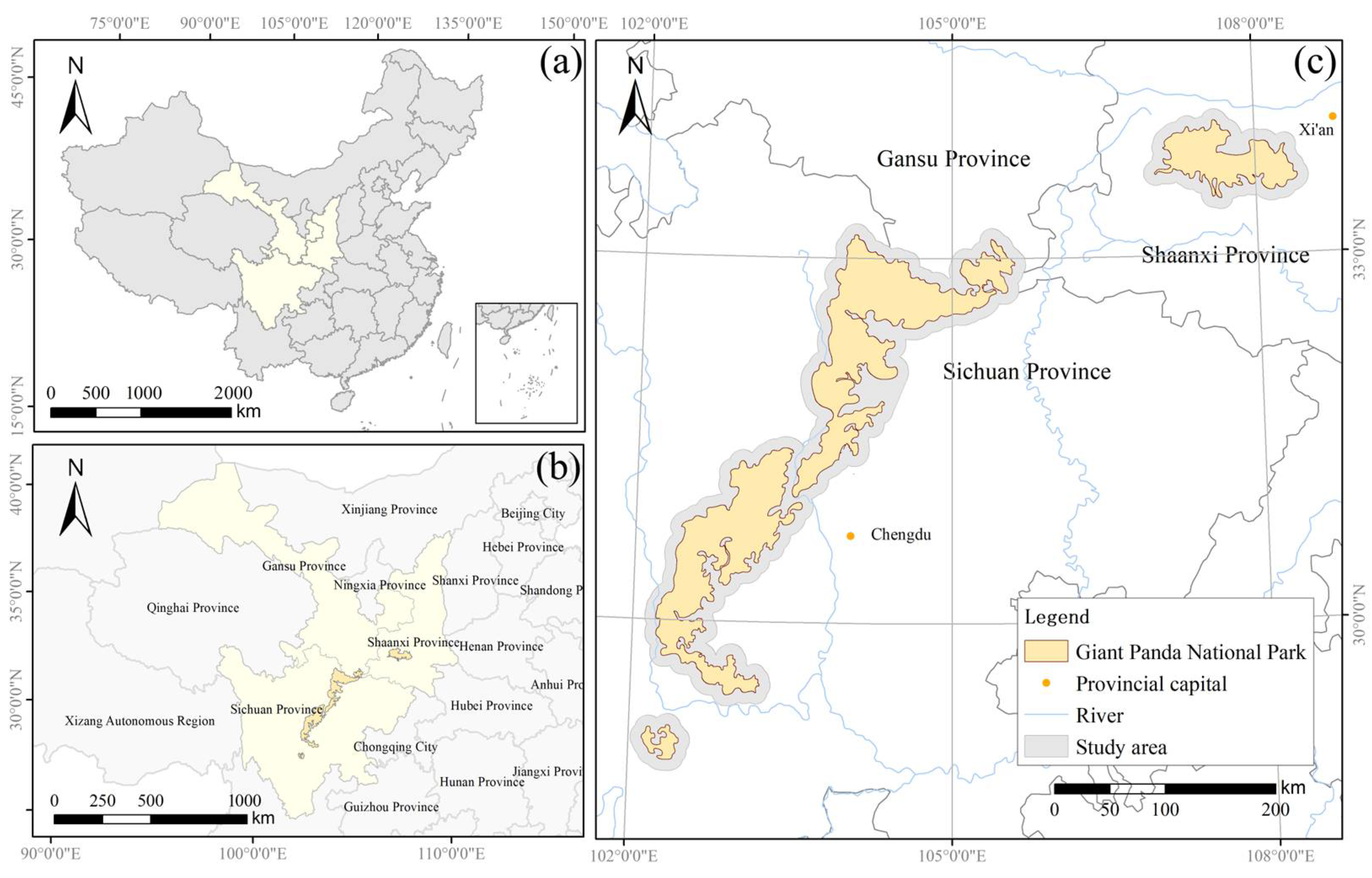
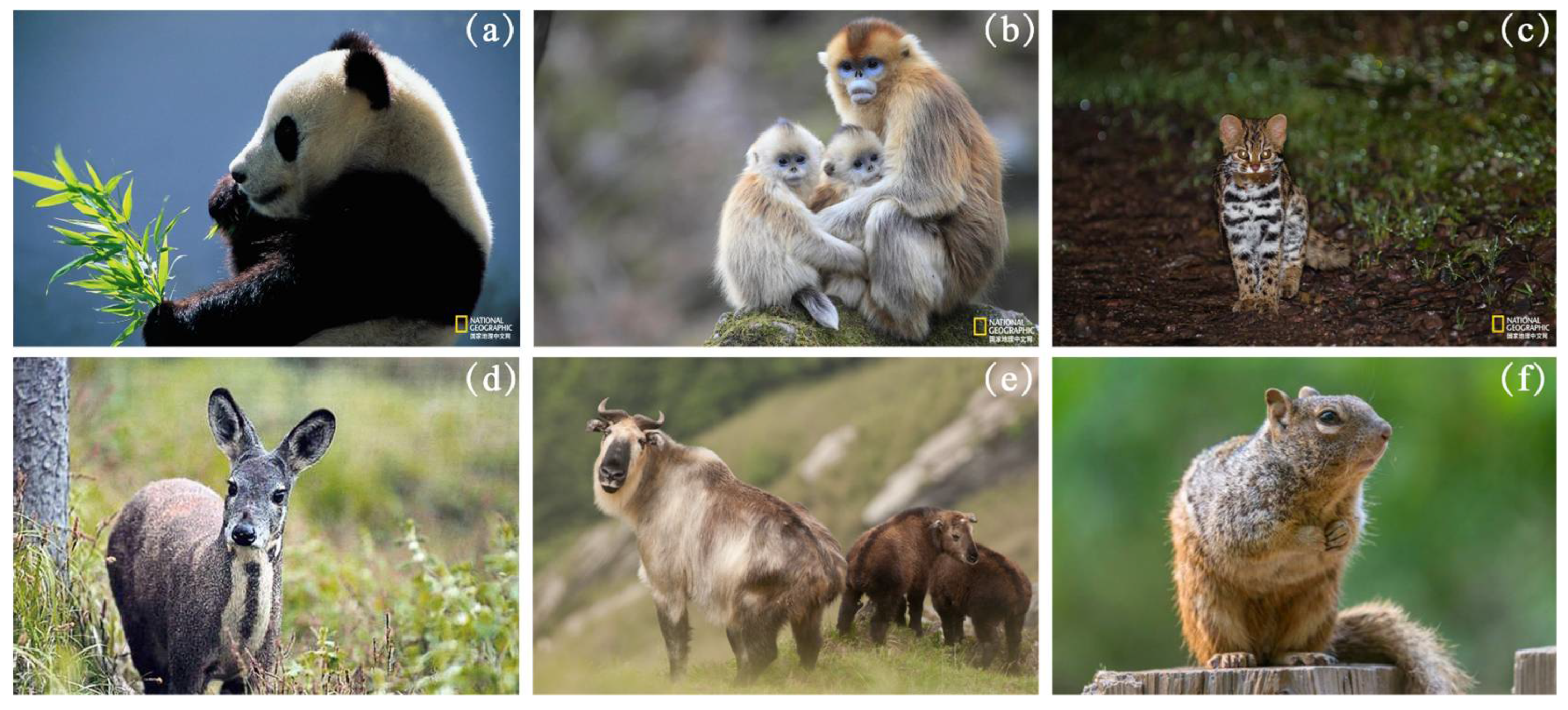


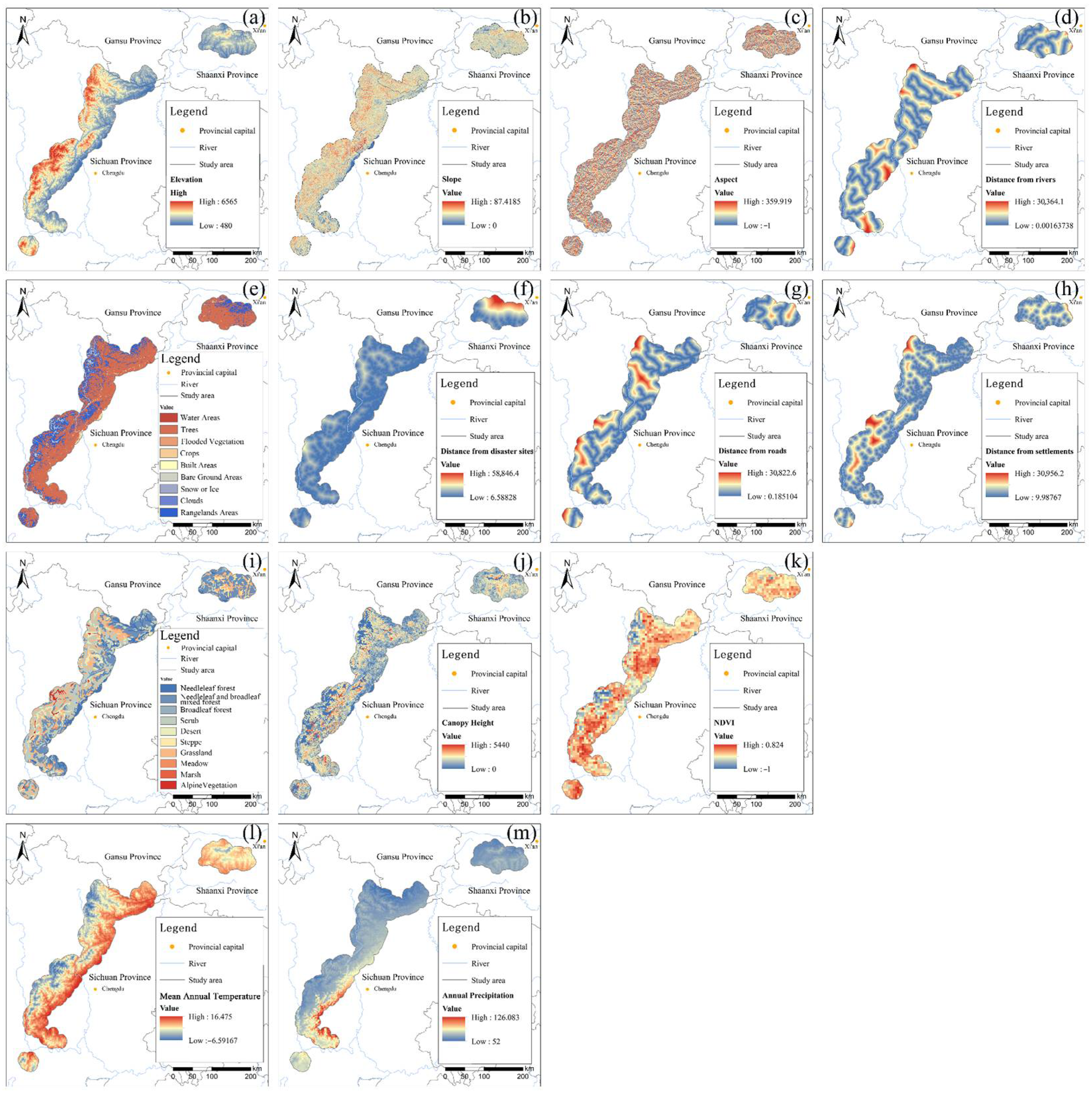


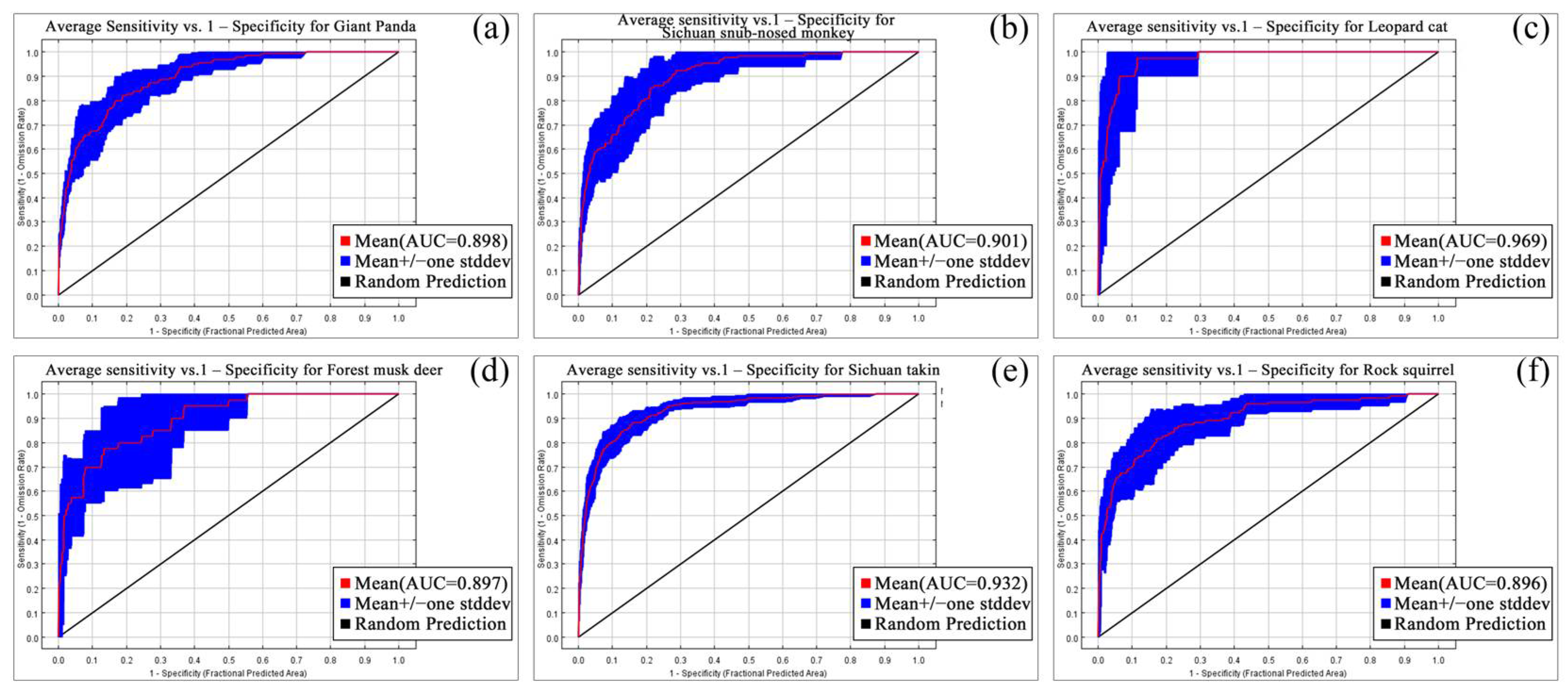
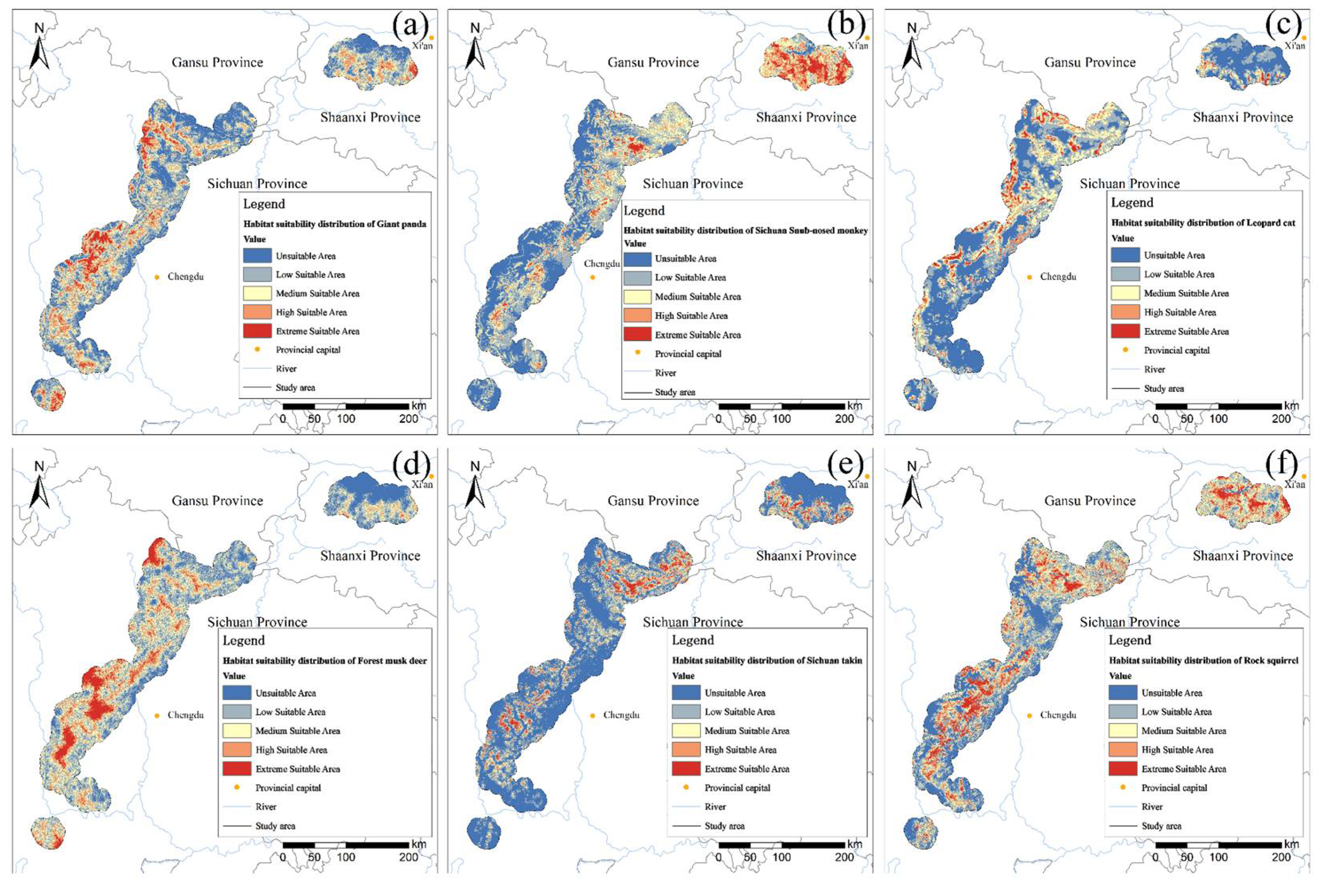
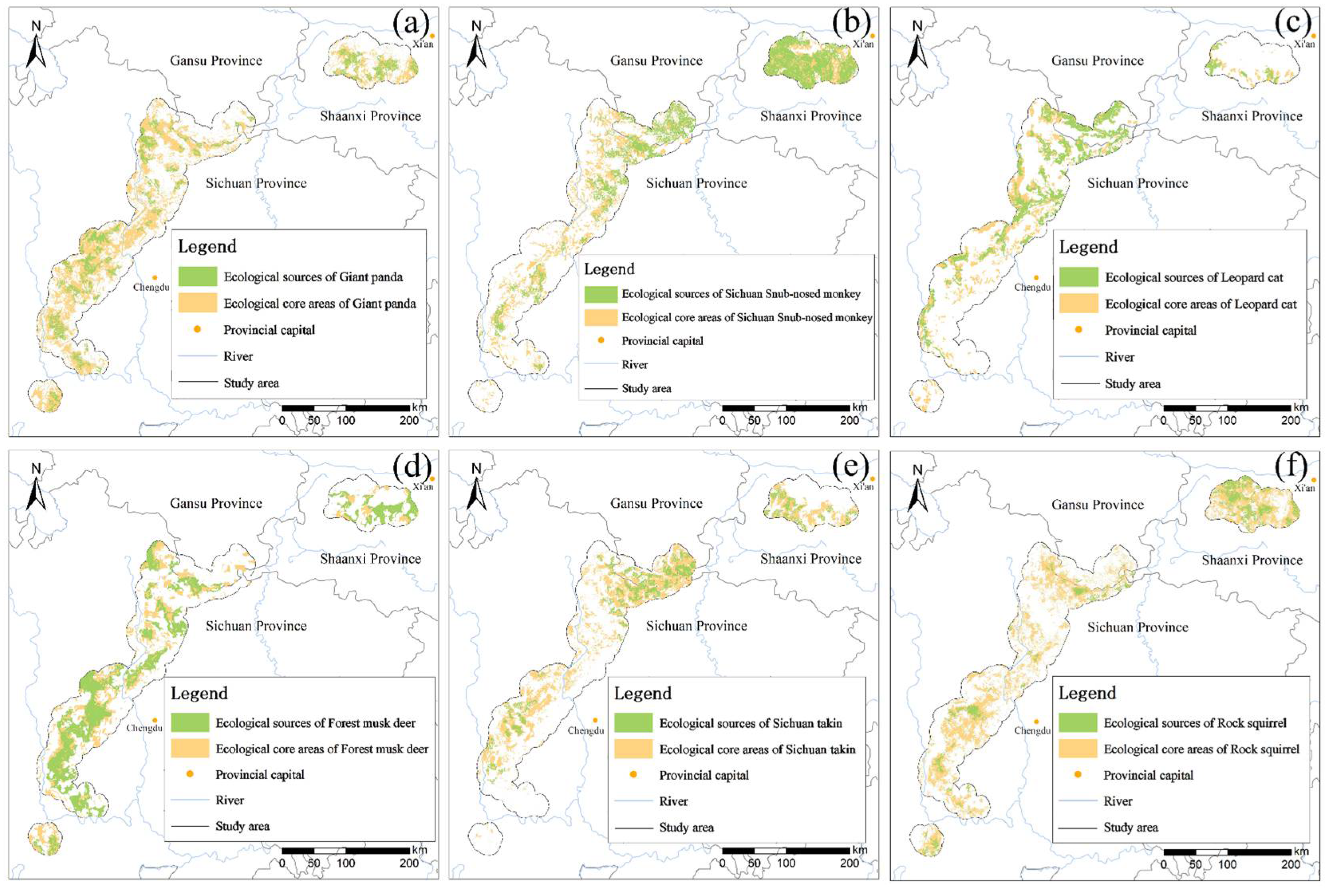
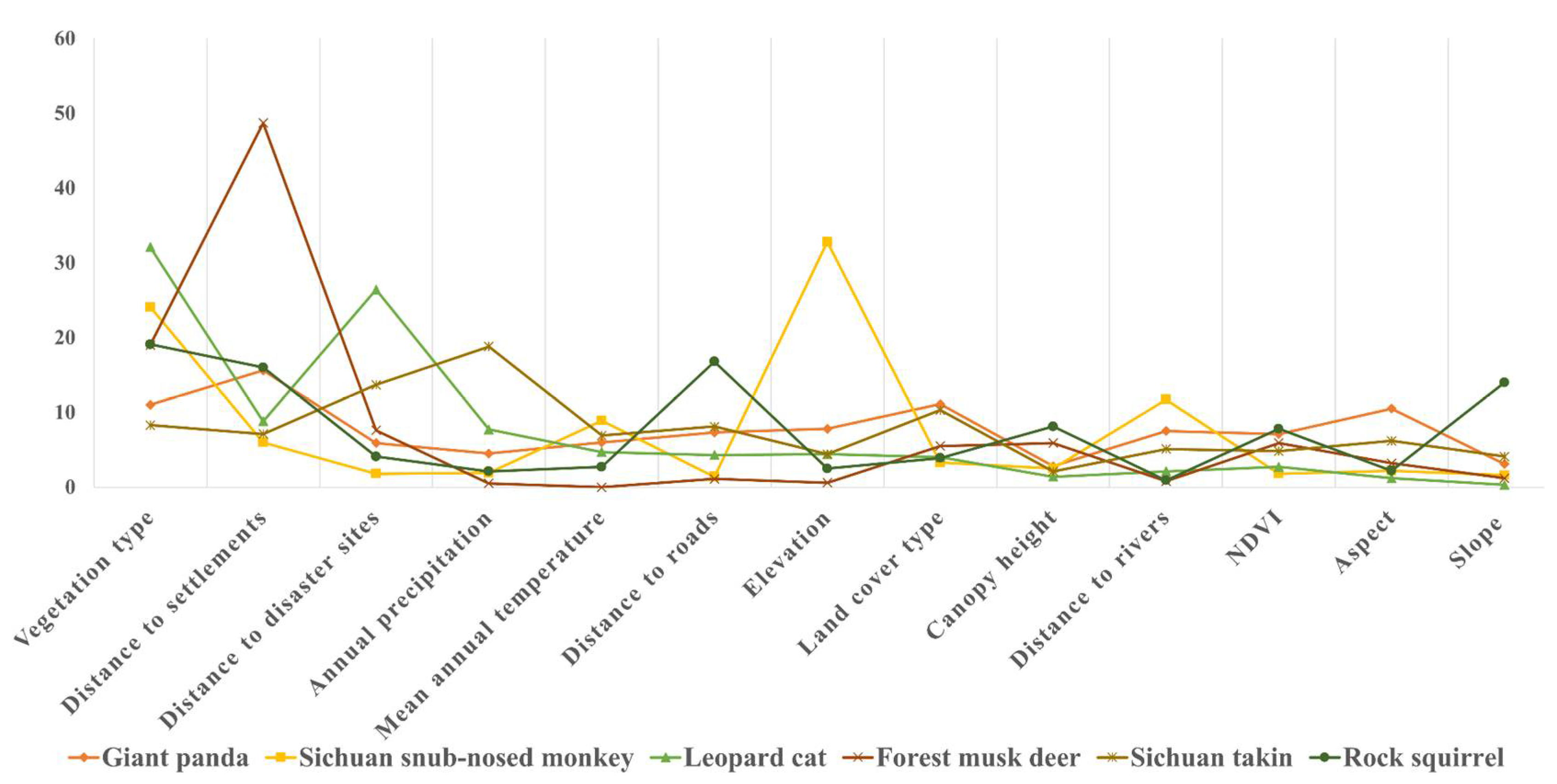

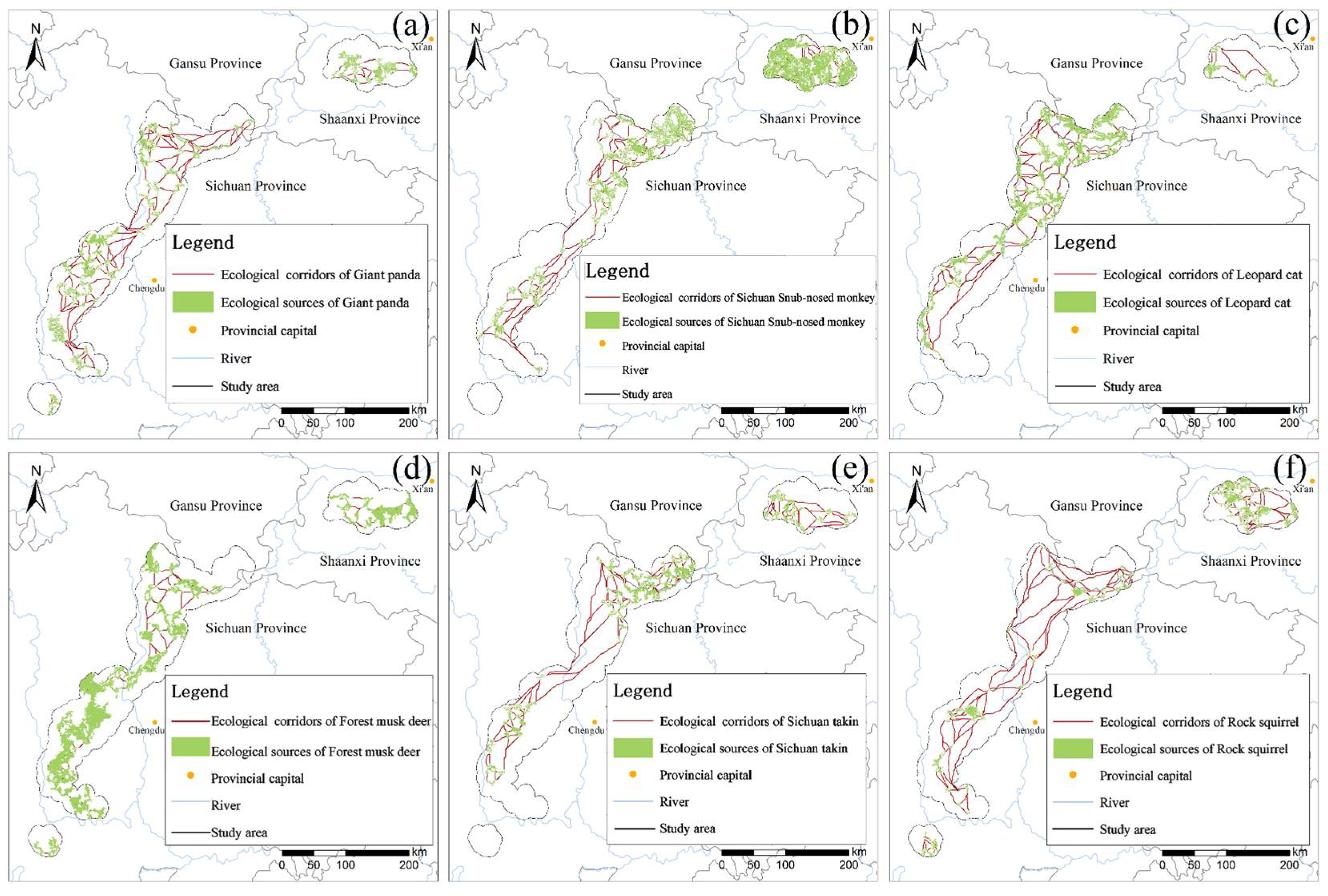
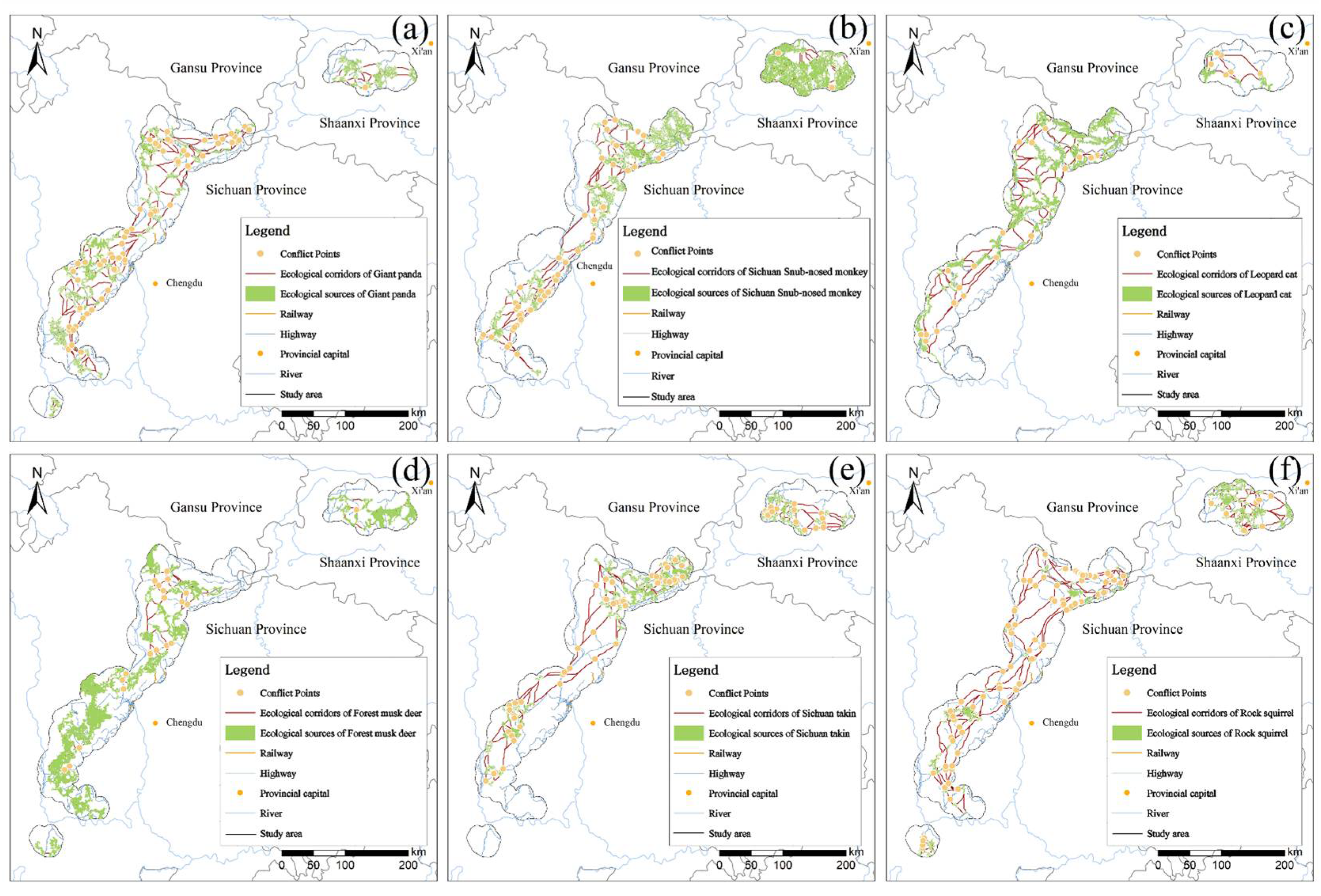

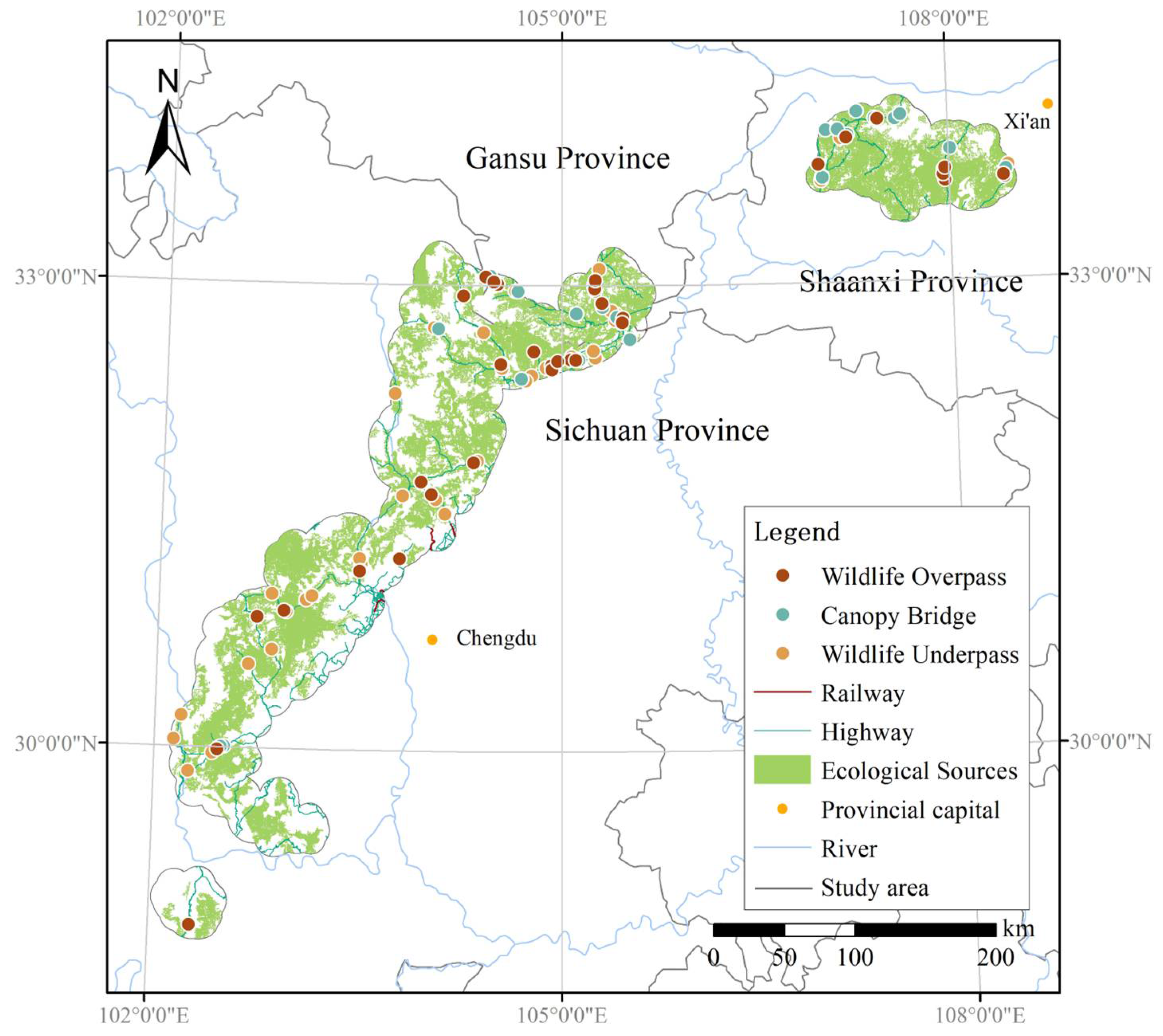

| Variable Category | Sub Variable |
|---|---|
| Geography | Slope |
| Elevation | |
| Aspect | |
| Distance to rivers | |
| Climatic factors | Annual precipitation |
| Mean annual temperature | |
| Biological factors | Canopy height |
| Vegetation type | |
| NDVI | |
| Disturbances | Land cover type |
| Distance to settlements | |
| Distance to roads | |
| Distance to disaster sites |
| Data | Sources | Spatial Accuracy |
|---|---|---|
| Species distribution data | GBIF Global Biodiversity Information Facility https://www.gbif.org/ (accessed on 12 September 2024) | —— |
| DEM data | Geospatial Data Cloud | 30 m |
| Water data | Open Street Map | —— |
| Precipitation data | World Clim Global Climate Data official website | —— |
| Temperature data | World Clim Global Climate Data official website | —— |
| Vegetation canopy height | Neural network guided interpolation for mapping canopy height of China′s forests by integrating GEDI and ICE-Sat-2 data. [17] | 30 m |
| NDVI data | http://www.nesdc.org.cn/ (accessed on 19 September 2024) | 30 m |
| Vegetation type | National Cryosphere Desert Data Center | 1:100 million |
| Settlement data | National Bureau of Statistics | —— |
| Land cover data | Esri | Sentinel-2 Land Cover Explorer | 10 m |
| Natural disaster sites | Resource and Environmental Science Data Platform | —— |
| Roads data | Open Street Map | —— |
| Habitat Suitability Zone | Medium-Suitability Area (km2) | Medium-Suitability Percentage (%) | High-Suitability Area (km2) | High-Suitability Percentage (%) | Extreme High-Suitability Area (km2) | Extreme High-Suitability Percentage (%) |
|---|---|---|---|---|---|---|
| Giant panda | 11,779 | 5.51 | 7674 | 14.57 | 2902 | 22.36 |
| Leopard cat | 9035 | 17.15 | 3865 | 7.34 | 1723 | 3.27 |
| Sichuan snub-nosed monkey | 10,967 | 20.82 | 618 | 11.73 | 269 | 5.11 |
| Forest musk deer | 1370 | 26.01 | 776 | 14.73 | 3879 | 7.36 |
| Rock squirrel | 11,966 | 22.72 | 8468 | 16.08 | 4745 | 9.01 |
| Sichuan takin | 6095 | 11.57 | 3660 | 6.95 | 2272 | 4.31 |
| Species | Ecological Source Area (km2) | Number (Pcs) | Percentage of Study Area Occupied (%) |
|---|---|---|---|
| Giant panda | 5319 | 86 | 10.06 |
| Leopard cat | 7045 | 69 | 13.33 |
| Sichuan snub-nosed monkey | 9871 | 86 | 18.67 |
| Forest musk deer | 12,023 | 50 | 22.75 |
| Rock squirrel | 3338 | 90 | 6.31 |
| Sichuan takin | 3956 | 75 | 7.48 |
| Species | Weight | Environment Variable | Grading Criteria | ||||
|---|---|---|---|---|---|---|---|
| 1 | 2 | 3 | 4 | 5 | |||
| Giant panda | 0.30 | Distance to settlements | 15.8–30.9 km | 10.2–15.8 km | 6.4–10.2 km | 3.1–6.4 km | ≤3.1 km |
| 0.20 | Land cover type | trees | water, rangelands | snow or ice | crops | built, bare ground | |
| 0.20 | Vegetation type | needleleaf and broadleaf mixed forest | scrub, grassland | desert | needleleaf, broadleaf forest | steppe, meadow, alpine vegetation | |
| 0.20 | Aspect | −1–70.9° | 70.9–141.4° | 141.4–211.9° | 211.9–283.8° | 283.8–359.9° | |
| 0.10 | Elevation | 454–1466 m | 1466–2136 m | 2136–2877 m | 2877–3724 m | 3724–7107 m | |
| Sichuan snub-nosed monkey | 0.40 | Elevation | 454–1466 m | 1466–2136 m | 2136–2877 m | 2877–3724 m | 3724–7107 m |
| 0.30 | Vegetation type | grassland | desert | needleleaf and broadleaf mixed forest, needleleaf forest, alpine vegetation | broadleaf forest, steppe | scrub | |
| 0.15 | Distance to rivers | 17,328–30,593 km | 11,472–17,328 km | 7289–11,472 km | 3466–7289 km | ≤3466 km | |
| 0.075 | Distance to settlements | 15.8–30.9 km | 10.2–15.8 km | 6.4–10.2 km | 3.1–6.4 km | ≤3.1 km | |
| 0.075 | Mean annual temperature | 11.9–16.6 °C | 8.8–11.9 °C | 5.5–8.8 °C | 1.5–5.5 °C | −6.5–1.5 °C | |
| Leopard cat | 0.40 | Vegetation type | grassland | scrub | needleleaf and broadleaf mixed forest, needleleaf, broadleaf forest | desert, steppe, meadow | alpine vegetation |
| 0.35 | Distance to disaster sites | 0.71–4142 km | 4142–9665 km | 9665–19,560 km | 19,560–33,828 km | 33,828–58,911 km | |
| 0.10 | Annual precipitation | 52–64.7 mm | 64.7–72.5 mm | 72.5–83.1 mm | 83.1–97.0 mm | 97.0–126.0 mm | |
| 0.10 | Distance to settlements | 15.8–30.9 km | 10.2–15.8 km | 6.4–10.2 km | 3.1–6.4 km | ≤3.1 km | |
| 0.05 | Mean annual temperature | 11.92–16.69 °C | 8.8–11.92 °C | 5.5–8.8 °C | 1.53–5.5 °C | −6.59–1.53 °C | |
| Forest musk deer | 0.50 | Distance to settlements | 15.8–30.9 km | 10.2–15.8 km | 6.4–10.2 km | 3.1–6.4 km | ≤3.1 km |
| 0.20 | Vegetation type | grassland | needleleaf and broadleaf mixed forest | scrub, alpine vegetation | needleleaf, broadleaf forest, desert, steppe | marsh | |
| 0.15 | Distance to disaster sites | 33.83–58.91 km | 19.56–33.83 km | 9.67–19.56 km | 4.14–9.67 km | ≤4.14 km | |
| 0.075 | Canopy height | ≤4.82 cm | 4.82–12.12 cm | 12.12–17.92 cm | 17.92–25 cm | 25–62.7 cm | |
| 0.075 | NDVI | 0.615–0.824 | 0.521–0.615 | 0.425–0.521 | 0.293–0.425 | −1.293 | |
| Sichuan takin | 0.35 | Annual precipitation | 52–64.7 mm | 64.7–72.5 mm | 72.5–83.1 mm | 83.1–97.0 mm | 97.0–126.0 mm |
| 0.25 | Distance to disaster sites | 17.9–30.8 km | 12.0–17.9 km | 7.3–12.0 km | 3.3–7.3 km | ≤4.1 km | |
| 0.20 | Land cover type | flooded vegetation | rangelands | water, trees, crops, bare ground, clouds | snow or ice | built | |
| 0.10 | Vegetation type | scrub, steppe | grassland | alpine vegetation, needleleaf and broadleaf mixed forest | broadleaf forest, meadow | desert | |
| 0.10 | Distance to roads | 15.8–30.9 km | 10.2–15.8 km | 6.4–10.2 km | 3.1–6.4 km | ≤3.3 km | |
| Rock squirrel | 0.25 | Vegetation type | needleleaf and broadleaf mixed forest | cultivated vegetation | needleleaf forest, meadow, alpine vegetation | desert, grassland | scrub |
| 0.20 | Distance to roads | 15.8–30.9 km | 10.2–15.8 km | 6.4–10.2 km | 3.1–6.4 km | ≤3.3 km | |
| 0.20 | Distance to settlements | 15.8–30.9 km | 10.2–15.8 km | 6.4–10.2 km | 3.1–6.4 km | ≤3.1 km | |
| 0.20 | Slope | 0–14.4° | 14.4–24.1° | 24.1–32.6° | 32.6–42.9° | 42.9–87.8° | |
| 0.15 | Canopy height | 25–62.7 cm | 17.9–2 cm | 12.1–17.9 cm | 4.8–12.1 cm | ≤4.8 cm | |
Disclaimer/Publisher’s Note: The statements, opinions and data contained in all publications are solely those of the individual author(s) and contributor(s) and not of MDPI and/or the editor(s). MDPI and/or the editor(s) disclaim responsibility for any injury to people or property resulting from any ideas, methods, instructions or products referred to in the content. |
© 2025 by the authors. Licensee MDPI, Basel, Switzerland. This article is an open access article distributed under the terms and conditions of the Creative Commons Attribution (CC BY) license (https://creativecommons.org/licenses/by/4.0/).
Share and Cite
Li, X.; Zhu, G.; Sun, J.; Wu, L.; Peng, Y. Research on the Coordination of Transportation Network and Ecological Corridors Based on Maxent Model and Circuit Theory in the Giant Panda National Park, China. Land 2025, 14, 1465. https://doi.org/10.3390/land14071465
Li X, Zhu G, Sun J, Wu L, Peng Y. Research on the Coordination of Transportation Network and Ecological Corridors Based on Maxent Model and Circuit Theory in the Giant Panda National Park, China. Land. 2025; 14(7):1465. https://doi.org/10.3390/land14071465
Chicago/Turabian StyleLi, Xinyu, Gaoru Zhu, Jiaqi Sun, Leyao Wu, and Yuting Peng. 2025. "Research on the Coordination of Transportation Network and Ecological Corridors Based on Maxent Model and Circuit Theory in the Giant Panda National Park, China" Land 14, no. 7: 1465. https://doi.org/10.3390/land14071465
APA StyleLi, X., Zhu, G., Sun, J., Wu, L., & Peng, Y. (2025). Research on the Coordination of Transportation Network and Ecological Corridors Based on Maxent Model and Circuit Theory in the Giant Panda National Park, China. Land, 14(7), 1465. https://doi.org/10.3390/land14071465





